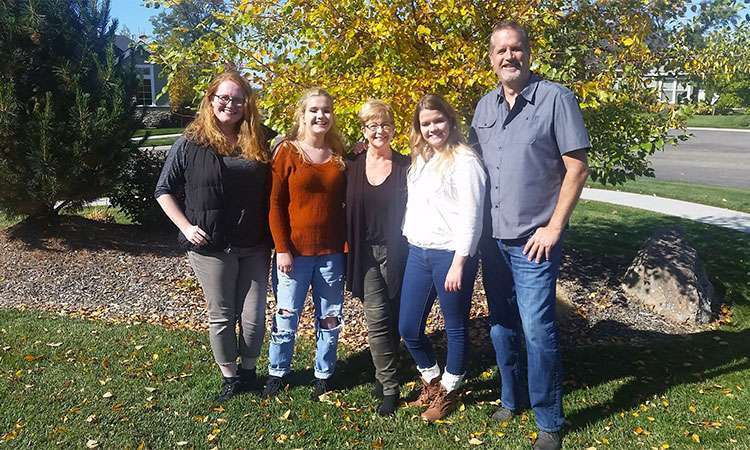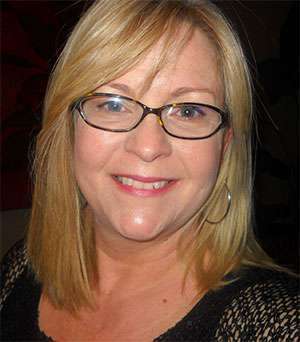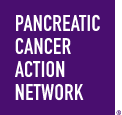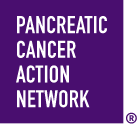
Pancreatic cancer survivor Gail Bamer, center, with her husband and three daughters
Editor’s note: Sadly, Gail Bamer died in July 2019. We are grateful to her for allowing her story to be shared.
After more than a year and a half of abdominal pain and digestive issues, Gail Bamer was diagnosed with stage IV pancreatic cancer in November 2017. With disease spread to her liver, she was told she had less than a year to live.
A mother of three daughters, Bamer was 53 years old at the time of her diagnosis and living in Eagle, Idaho, a suburb of Boise.
“I am very frustrated with how I was diagnosed,” Bamer said. “I think general practice physicians need to know a lot more about pancreatic cancer.
“I went to my doctor with a full page listing my symptoms and a specific timeline, and she did not refer me to a gastroenterologist. If I could go back in time, I would have insisted on a CT scan.”
Bamer was presented with two chemotherapy regimens to choose between, and she opted for the one with less severe anticipated side effects to preserve her quality of life.
“Someone at the cancer center told me to contact the Pancreatic Cancer Action Network (PanCAN), but with no details as to how that would help,” Bamer said. “What you may not realize is that many oncologists (especially in smaller cities like mine) rarely deal with pancreatic cancer.”

Gail Bamer credits PanCAN Patient Services for helping her find a clinical trial.
She continued, “I went to pancan.org and found information about Patient Services and the Know Your Tumor® precision medicine service and immediately knew I had to submit my biopsy tissue.”
Through Know Your Tumor, pancreatic cancer patients and their doctors can gain information about the unique biological characteristics of their tumor – and determine whether there are treatment types that may be particularly beneficial for that patient.
Patients are encouraged to enroll in Know Your Tumor while receiving treatment so that the report can provide insight into the patient’s next treatment decision, if needed.
In Bamer’s case, this was highly valuable.
“After six weeks of chemotherapy, I learned that the treatment was not working. I was advised to switch to a different chemotherapy regimen,” she recalled.
But her oncologist, who was on maternity leave at the time, reached out to the cancer center from home to point out that Bamer’s Know Your Tumor report showed that she qualified for an immunotherapy clinical trial – and receiving additional chemotherapy would make her ineligible.
“We immediately made an appointment at Oregon Health & Science University (OHSU) – 435 miles away from home – to inquire about the clinical trial,” Bamer said. “I was deemed eligible for the trial and began the prescreening process in February 2018.
“My new oncologist at OHSU told me that, but for my cancer, I was in perfect health.”
The trial required Bamer to be in Portland Monday through Friday for seven weeks, traveling home only on weekends. She described the nearly 1,000-mile roundtrip weekly journey as, “frustrating and exhausting.”
And her first CT scan after starting the trial showed discouraging news. “My cancer had grown,” she said. “My oncologist said the growth was consistent with getting no treatment at all.”
Bamer recalls that she almost chose to quit the trial and start a chemotherapy regimen. However, her immunotherapy clinical trial included an option to “roll over” onto a different arm of treatment within the trial if the initial regimen did not work.
Logistically, this new arm of the trial was easier for Bamer and her family, requiring daily pills and traveling for an IV infusion once every two weeks. And most importantly, her tumors began responding.
“I officially achieved a ‘partial response’ on the trial with 30 percent tumor shrinkage,” she said.
Today, Bamer continues to take the study medication. She said, “I hope the trial drugs continue to shrink my tumors, but at the very least, I hope they keep my disease stable. I’m always hoping there’s a cure right around the corner.”
Reflecting on the path that brought her to the clinical trial, Bamer said, “I really feel that the Know Your Tumor program saved me.
“Contacting PanCAN was the best thing I did, and I tell everyone about it.”
Bamer has also chosen to give back to the research community by participating in PanCAN’s Patient Registry, a global online database created to look for patterns in treatments, side effect management and diagnostics that will lead to improved treatment options and outcomes for patients.
“I think the registry is so important – collecting information from patients is a concrete way of gathering data to fight this disease,” Bamer said. “It’s important for researchers to know the ‘real-life’ experiences of patients: their symptoms, their treatments and side effects, their CT scan results and CA 19-9 results.”
Bamer added, “All the data in the Patient Registry gives a big picture of the disease, outside of scientific research. All this data is needed to find a cure.”
Any treatments, including clinical trials, mentioned in this story may not be appropriate or available for all patients. Doctors take many things into account when prescribing treatments including the stage and type of cancer and the overall health of the patient. Contact PanCAN Patient Services for personalized treatment options.





